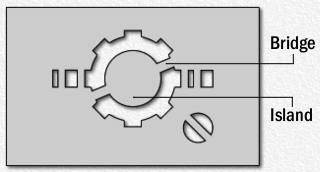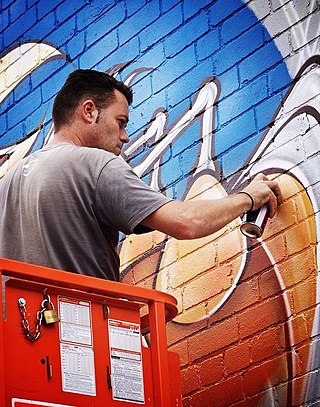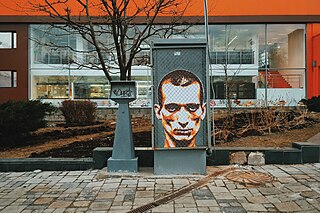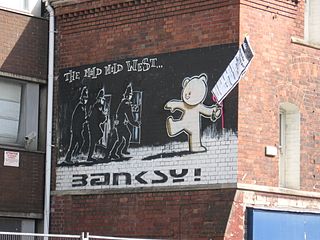Related Research Articles

Graffiti is art that is written, painted or drawn on a wall or other surface, usually without permission and within public view. Graffiti ranges from simple written words to elaborate wall paintings, and has existed since ancient times, with examples dating back to ancient Egypt, ancient Greece, and the Roman Empire.

A mural is any piece of graphic artwork that is painted or applied directly to a wall, ceiling or other permanent substrate. Mural techniques include fresco, mosaic, graffiti and marouflage.

Paint is a liquid pigment that, after applied to a solid material and allowed to dry, adds a film-like layer. As art, this is used to create an image, known as a painting. Paint can be made in many colors and types. Most paints are either oil-based or water-based, and each has distinct characteristics.

Stencilling produces an image or pattern on a surface by applying pigment to a surface through an intermediate object, with designed holes in the intermediate object. The holes allow the pigment to reach only some parts of the surface creating the design. The stencil is both the resulting image or pattern and the intermediate object; the context in which stencil is used makes clear which meaning is intended. In practice, the (object) stencil is usually a thin sheet of material, such as paper, plastic, wood or metal, with letters or a design cut from it, used to produce the letters or design on an underlying surface by applying pigment through the cut-out holes in the material.

Banksy is a pseudonymous England-based street artist, political activist, and film director whose real name and identity remain unconfirmed and the subject of speculation. Active since the 1990s, his satirical street art and subversive epigrams combine dark humour with graffiti executed in a distinctive stenciling technique. His works of political and social commentary have appeared on streets, walls, and bridges throughout the world. His work grew out of the Bristol underground scene, which involved collaborations between artists and musicians. Banksy says that he was inspired by 3D, a graffiti artist and founding member of the musical group Massive Attack.

Robert Del Naja, also known as 3D, is a British artist, musician, singer and songwriter. He emerged as a graffiti artist and member of the Bristol collective the Wild Bunch, and later as a founding member and sole consistent member of the band Massive Attack, with which he is still active. In 2009, he received the British Academy's Ivor Novello Award for Outstanding Contribution to British Music.

Street art is visual art created in public locations for public visibility. It has been associated with the terms "independent art", "post-graffiti", "neo-graffiti" and guerrilla art.

Phibs is the pseudonym of Tim De Haan, a notable graffiti artist operating out of Sydney, Australia.

Since the 1980s, the area surrounding the Sydney inner west suburb of Newtown, Australia, including the suburbs of Newtown, Enmore, Erskineville, Camperdown and St Peters, has been known for its wide range of prominent graffiti and street art on walls. The public visual art in the Newtown area consists of a variety of styles and methods of execution, including large-scale painted murals, hand-painted political slogans, hand-painted figurative designs, spray painted semi-abstract designs "tags"), and other stylistic developments such as stencil art and street poster art, "Yarn bombing", and sculptural items cast from plaster and other materials.

Digital graffiti is the act of creating graffiti art using a computer vision system. Various groups and companies have pioneered digital graffiti since technology advances made it possible. Most notably is the Graffiti Research Lab based in the US with their L.A.S.E.R. Tag system.

Dragons' Den is a British reality television business programme, presented by Evan Davis and based upon the original Japanese series. The show allows several entrepreneurs an opportunity to present their varying business ideas to a panel of five wealthy investors, the "Dragons" of the show's title, and pitch for financial investment while offering a stake of the company in return.

Peter David Jones is a British entrepreneur, businessman, investor and reality television personality, with interests in mobile phones, television, media, leisure, retail, and property. As the last remaining original investor on the BBC One show Dragons' Den, he has also appeared on other television shows with similar formats.

Blu is the pseudonym of an Italian artist who conceals his real identity. He was born in Senigallia. He lives in Bologna and has been active in street art since 1999.

Commercial graffiti is the commercial practice of graffiti artists being paid for their work. In New York City in particular, commercial graffiti is big business and since the 1980s has manifested itself in many of the major cities of Europe such as London, Paris and Berlin. Increasingly it has been used to promote video games and even feature prominently within them, reflecting a real life struggle between street artists and the law. Commercial graffiti has created significant controversy between those who view it as an effective medium of advertising amongst specific target audiences and those who believe that legal graffiti and advertising using it encourages illegal graffiti and crime.

Inkie is a London-based painter and street artist, originally from Clifton, Bristol. He is cited as being part of Bristol's graffiti heritage, along with Banksy, 3D and Nick Walker.
See No Evil is a collection of works of public art by multiple graffiti artists, located around Nelson Street in Bristol, UK. The artwork was first created in an event in August 2011 that was Europe's largest street art festival at the time. It culminated with a block party. The street was mostly repainted in a repeat event in 2012. The artworks comprise murals of various sizes, in different styles, some painted on tower blocks, including a 10-storey office block. The works were created under a road closure, using scaffolding and aerial work platforms.

In Russia, graffiti is an ambiguous phenomenon, i.e. considered to be desecration by some, and art by others. It is done for a variety of reasons, including expressing oneself through an art form, or protesting against a corporation or ideology.

The Mild Mild West is a 1999 mural by graffiti artist Banksy, sited on No. 80 Stokes Croft, Bristol. It depicts a teddy bear throwing a Molotov cocktail at three riot police.

Well Hung Lover, also called Naked Man Hanging From Window and simply Naked Man, is a mural by the anonymous street artist Banksy, on a wall in Frogmore Street, Bristol, England.
References
- ↑ "BBC - Dragons' den - Entrepreneurs - Tim Williams and Tom Hogan".
- ↑ "Digital graffiti wall for Bristol Festival". Bristol Evening Post. Bristol News and Media Ltd. 11 September 2009. Retrieved 2010-02-01.
- ↑ "Graffiti wall to light up harbour". BBC News. BBC Ltd. 9 September 2009. Retrieved 2010-02-09.